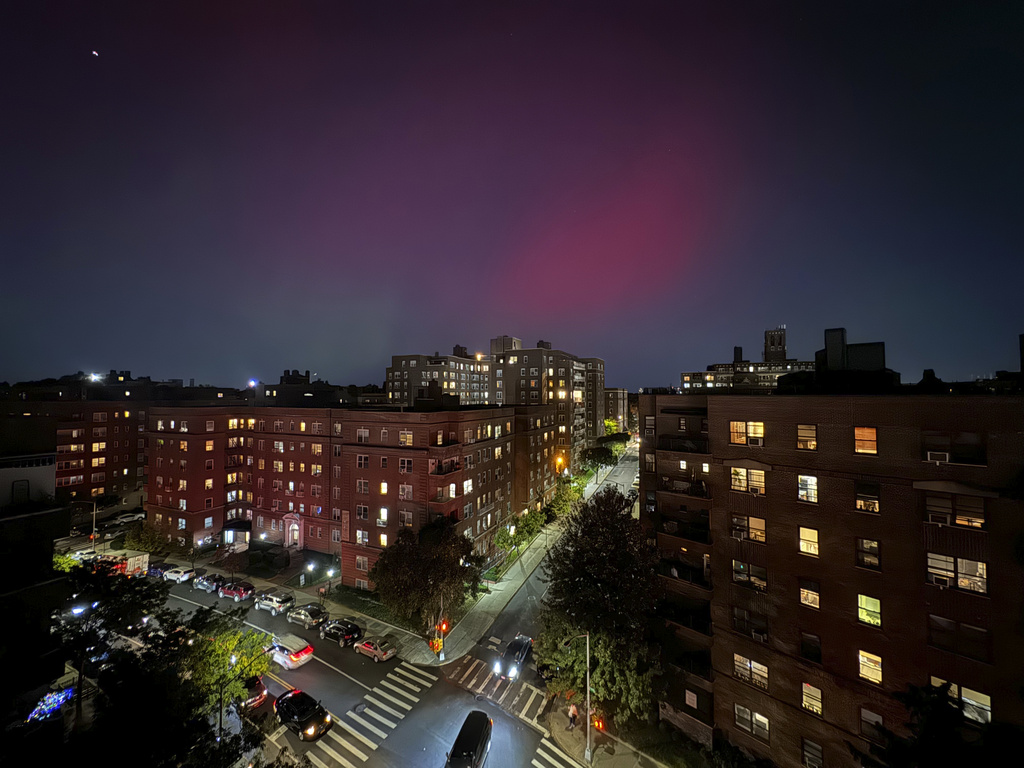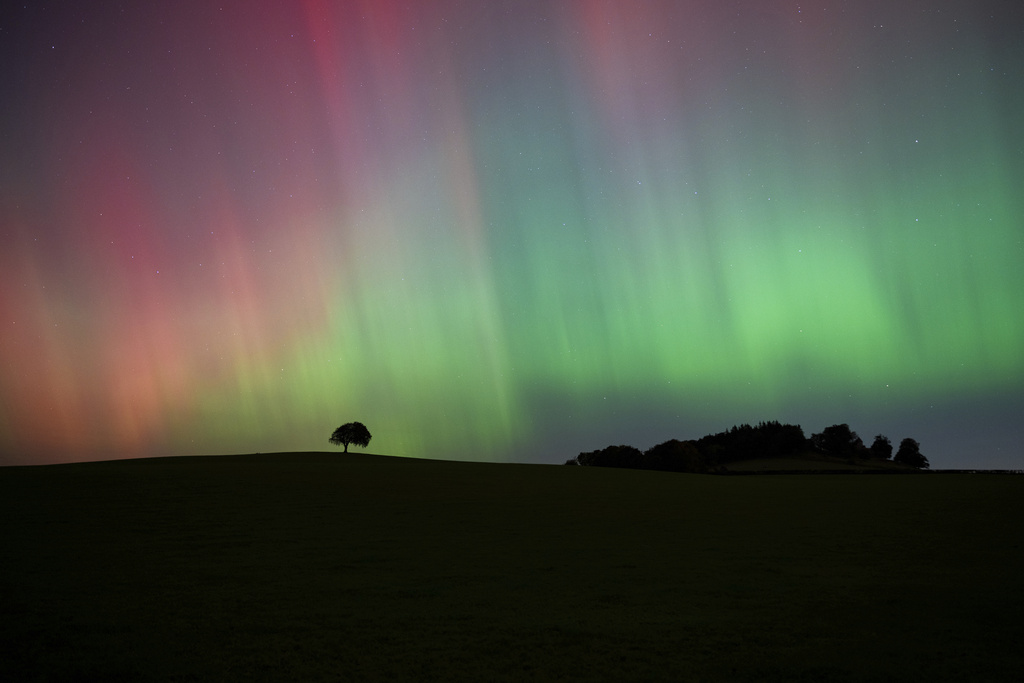Solar Storms Trigger Stunning Northern Lights Across Locations \ Newslooks \ Washington DC \ Mary Sidiqi \ Evening Edition \ A powerful solar storm produced vibrant northern lights in regions far south of their usual appearance, including New York City, Germany, and the UK. The U.S. National Oceanic and Atmospheric Administration (NOAA) issued severe geomagnetic storm alerts following a coronal mass ejection from the sun, leading to the spectacular light displays. The solar activity, part of the sun’s 11-year cycle, is expected to continue through 2026, with more auroras likely in the coming years. Despite the breathtaking views, there were no reports of power or communication disruptions.

Solar Storms Bring Northern Lights to Unprecedented Regions Quick Looks:
- An unusually strong solar storm has caused northern lights to be visible as far south as New York, Germany, and even New Mexico.
- NOAA issued severe geomagnetic storm alerts due to a massive coronal mass ejection (CME) from the sun, intensifying aurora activity worldwide.
- The storms have created brilliant displays of pink, green, purple, and blue skies across areas that normally do not experience northern lights.
- No disruptions to power or communication systems have been reported, but NOAA predicts continued high solar activity due to the ongoing solar maximum.
- As the sun nears the peak of its 11-year solar cycle, more solar storms and auroras are expected, potentially creating even more widespread displays.
Deep Look:
Another in a series of unusually strong solar storms has hit Earth, producing breathtaking northern lights in places where they are rarely seen, including New York City, Germany, the UK, and even as far south as New Mexico. The vibrant light shows have painted the night sky in hues of pink, purple, green, and blue, creating stunning visual spectacles far beyond the usual high-latitude regions where the auroras normally occur.
“This was a pretty extensive display yet again,” said Shawn Dahl, a space weather forecaster at NOAA’s Space Weather Prediction Center. Dahl noted that the northern lights have been seen in regions as far south as New Mexico, marking what he described as a “wonderful year” for aurora sightings.
What Causes Northern Lights?
Northern lights, or auroras, are typically visible in high-latitude regions close to the Earth’s poles. The phenomenon occurs when the sun releases bursts of energy and charged particles in a process known as a solar wind. While the Earth’s magnetic field protects us from the majority of these particles, some manage to travel down magnetic field lines near the poles and into Earth’s atmosphere.
Once the particles enter the atmosphere, they collide with gases like nitrogen and oxygen, creating the light displays we recognize as the northern and southern lights. The color of the aurora depends on the type of gas involved—green and red are produced by oxygen, while nitrogen produces blue and purple hues.
This latest solar storm was particularly powerful, the result of a coronal mass ejection (CME), a massive burst of energy from the sun’s outer atmosphere that interacts with the Earth’s magnetic field. According to NOAA, this CME’s magnetic orientation lined up well with the Earth’s field, intensifying the auroras and allowing them to be seen much farther south than usual.
“We stayed well connected,” said Dahl, referring to the alignment of the sun’s magnetism with Earth’s, which allowed for such a widespread display.
Solar Maximum and Increased Storm Activity
This stunning display of northern lights is part of a broader trend of increased solar activity. The sun operates in cycles, with periods of higher and lower activity that last approximately 11 years. Right now, the sun is near the peak of this cycle, known as a solar maximum, when solar storms, flares, and CMEs are more frequent and intense. Solar maximum periods typically result in more frequent and stronger auroras, as well as increased risks of geomagnetic storms that could disrupt communication and power grids.
Dahl explained that this period of solar maximum is expected to continue for several more years, with solar activity remaining high until at least 2026. In fact, earlier this year in May, the sun released its largest solar flare in almost two decades, followed by severe solar storms that triggered auroras across parts of the Northern Hemisphere that had never seen them before.
“We’re in the grip of the solar maximum,” Dahl said. “We’re in for more of the experiences we had last night.”
Aurora Sightings Around the World
The latest solar storm gave rise to northern lights visible as far south as New York City and New England, stunning city dwellers who are unaccustomed to seeing such vibrant natural displays. Reports also came in from the UK, Germany, and other parts of Europe, where the auroras were just as brilliant.
“We don’t typically get to see these lights in cities like this, so it was a real treat,” said Alice McIntyre, a resident of New York, who witnessed the auroras for the first time. “The skies were filled with these beautiful greens and pinks. It’s something I never expected to see here.”
Although the auroras provided breathtaking visuals, there have been no reports of disruptions to power grids or communications systems so far, despite the potential for such effects during geomagnetic storms. Solar storms like this one have the potential to interfere with satellite communications, GPS systems, and even the electrical grid, but none of these impacts were reported with this latest event.
Future Aurora Displays Expected
As we remain in the peak of the solar cycle, more solar storms and northern lights are expected in the coming years. This means that skywatchers across the world—especially those in regions where auroras are rarely seen—could have more opportunities to witness this extraordinary natural phenomenon.
The best chance to see the northern lights is during times of heightened solar activity, which often occur around the spring and fall equinoxes. This is because the alignment of the Earth’s magnetic field and the solar wind is more favorable during these periods, increasing the chances of aurora displays. According to NOAA, the best viewing times are typically an hour or two before or after midnight, and those hoping to catch the lights are advised to get away from city lights to minimize light pollution.
With more solar storms likely on the horizon, space weather forecasters like Dahl are keeping a close watch on the sun. “We’ll be keeping our eyes on the sun’s activity in the coming months,” he said. “It’s been a thrilling year, and we expect more incredible displays.”
How to See the Northern Lights
For those hoping to see the northern lights during future solar storms, NOAA has some advice. The best viewing times are typically around midnight, and the farther you can get from city lights, the better your chances of seeing the auroras. Clear skies are a must, as clouds can obscure the lights.
Because solar activity is high during the solar maximum, it’s also a good idea to check NOAA’s Space Weather Prediction Center website for alerts on upcoming storms and aurora forecasts.
With the sun entering a particularly active phase, the opportunities for catching a glimpse of the auroras have never been better—even for those who live in lower latitudes. So, whether you’re in the northern U.S. or parts of Europe, keep your eyes on the sky and you might just get to experience the magic of the northern lights.







